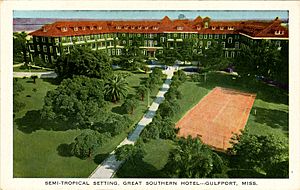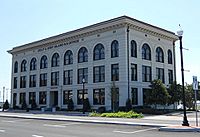Gulf and Ship Island Railroad facts for kids
| Overview | |
|---|---|
| Headquarters | Gulfport, Mississippi |
| Reporting mark | GSI |
| Locale | Mississippi |
| Dates of operation | 1882–1925 |
| Successor | Illinois Central Railroad |
| Technical | |
| Track gauge | 4 ft 8 1⁄2 in (1,435 mm) standard gauge |
| Length | 308 miles (496 km) |
The Gulf and Ship Island Railroad (G&SI) was a special train line built in Mississippi, USA. It was created around the year 1900. Its main goal was to help transport huge amounts of southern yellow pine trees. These trees were needed for building and other uses.
Building the railroad was not easy. There were many money problems. But two important people, William H. Hardy and Joseph T. Jones, worked hard to finish it. The railroad helped create a new seaport and made cities along its path grow bigger.
Contents
How the Railroad Started
The idea for the Gulf and Ship Island Railroad (G&SIRR) began with special permissions called "charters." These charters were given by the Mississippi State Legislature. The first one was in 1850, and another in 1856.
However, the second charter did not get used for 31 years. This was because of the American Civil War and the time after it, called Reconstruction. Finally, in 1887, the state government approved a third charter. This allowed the railroad project to move forward.
William H. Hardy's Vision
In 1887, William H. Hardy became the president of the G&SIRR. He had support from other important railroad investors. Hardy wanted to build a standard-sized railroad. It would start somewhere on the Gulf of Mexico coast in Mississippi.
His big idea was for the train line to go from the Gulf Coast all the way north through Mississippi to Jackson, Tennessee. Hardy made some smart changes to the route over time. He decided the railroad should cross another line at a spot he named Hattiesburg. He named this city after his wife, Hattie Lott Hardy.
At first, Mississippi City was thought to be the best place for the railroad's end point on the Gulf. But Hardy found that it was too far from a natural deep-water harbor. This harbor was protected by Ship Island. So, he suggested building a brand new city called Gulfport as the railroad's main port.
Building the Tracks
Building the G&SIRR started in 1888. For a short time, the work was done by prisoners. They were part of a system where the state rented out their labor. But this system stopped when officials found that the workers were being treated badly.
After that, other companies took over the construction. But they also faced problems and went bankrupt. William H. Hardy worked very hard to find new investors. He looked for money in the northern and western U.S., and even in Europe. But the economy after the Civil War made it very difficult. Because of these money problems, the G&SIRR ran into serious trouble by 1896.
Joseph T. Jones Takes Over
By the late 1800s, Joseph T. Jones had become very rich. He made his money from oil wells and pipelines in Pennsylvania and West Virginia. He heard about the struggling railroad in Mississippi. It came with a lot of land, including 63,000 acres of timberland. There were also another 400,000 acres of timberland nearby that could be used.
Jones and other investors created a company called Bradford Construction Company. They bought the railroad that was having financial problems. Their plan was to finish building it and use the timberland. The longest part of the G&SIRR was completed by Jones's company.
In 1901, Jones bought out his partners. His company then joined with the Gulf and Ship Island Railroad Company. Joseph T. Jones also had the Great Southern Hotel built in Gulfport. This was his home on the Gulf Coast. A new office building for the railroad company was also built nearby.
Even though Joseph T. Jones took over, William H. Hardy stayed involved. He was a board member until 1899. In 1895, Hardy was elected to the Mississippi State Legislature. This meant he spent more time at the State Capital in Jackson. This limited his direct involvement with the railroad.
Where the Railroad Went
On January 1, 1897, the railroad line between Gulfport and Hattiesburg was finished. It took another three and a half years for the line to open between Hattiesburg and Jackson. This happened on July 4, 1900.
The Gulf and Ship Island Railroad operated only within the state of Mississippi. The company owned about 160 miles (257 km) of main train line. It also had 147 miles (237 km) of smaller branch lines. Plus, there were 106 miles (171 km) of tracks just in Gulfport.
The main line started at Gulfport and went north to Jackson, Mississippi. Branch lines connected to towns like Maxie, Mendenhall, and Laurel. Other lines went to towns such as Pontotoc and Ripley. Some even reached areas near the Tennessee River in northeastern Mississippi.
The G&SIRR helped open up huge areas of southern yellow pine trees for cutting. Logging and lumber companies quickly appeared in towns along the railroad. They used the trains to move logs to sawmills and lumber to sell in markets. By 1902, the 74 miles (119 km) of G&SIRR between Gulfport and Hattiesburg had a sawmill and a turpentine distillery about every 3 miles (4.8 km). In 1907 alone, about 800 million board feet of southern yellow pine lumber was carried on the G&SIRR.
Trade and Impact
The G&SIRR Company also managed a 6-mile (9.7-km) long channel in the Gulf of Mexico. This channel connected the mainland to Ship Island. In 1902, a shipping channel was dug. It linked Ship Island and the main railroad terminal at Gulfport.
The G&SIRR greatly helped the port of Gulfport grow. Between 1903 and 1907, more than a billion board feet of timber was shipped out of Gulfport. In 1908, the first shipment of cotton was sent out by steamship. In the early years, items like phosphates, iron pyrite, creosote oil, and mahogany were brought into Gulfport. From 1910 to 1913, the Port of Gulfport shipped more timber than any other port in the world.
Mississippi gained a lot from the G&SIRR. The railroad helped towns along its route develop. It created a huge timber industry. It also led to the creation of the city of Gulfport and a deep-water seaport. Starting in 1924, the G&SIRR became part of the Illinois Central Railroad. It lost its own name and identity in 1946.





